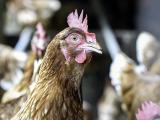Nov 3, 2006 (CIDRAP News) – Because federal officials expect to keep finding low-pathogenic H5N1 avian influenza viruses in wild birds, they recently announced a new procedure for reporting the findings: posting them online but not issuing news releases.
Since August the US Department of Agriculture (USDA) and Department of the Interior (DOI) have announced 12 avian flu detections as part an expanded wild bird monitoring program, and all have been low-pathogenic forms, which pose no human health risk.
Low-pathogenic avian flu viruses often occur naturally in wild birds and cause only minor sickness or no noticeable disease. However, low-pathogenic strains sometimes mutate into deadly strains.
In an Oct 26 news release, the USDA and DOI said they expected to find additional cases of the low-pathogenic "North American" strain of H5N1 in wild birds in coming months. The agencies said they would list all routine detections on the National Highly Pathogenic Avian Influenza Early Detection System (HEDDS) (see link below). The USDA will also include a link to the list on its Web site.
In unusual cases, such as a large number of sick or dead birds or a finding that suggests a highly pathogenic virus, the agencies will issue a news release or hold a technical briefing to alert the media and public, officials said.
Since the USDA and DOI switched to online reporting of low pathogenic cases, there have been four new reports of such findings in wild birds. They include mallard ducks killed by hunters in St Claire County, Mich., Grundy County, Ill., and Niagara County, N.Y., and a green-winged teal killed by a hunter in Tuscola County, Mich. Confirmatory testing is underway in all four instances.
As they announced the new reporting protocol, the federal agencies said avian flu had been ruled out in a previously announced suspected case in Ohio. In mid October the agencies reported finding H5 and N1 avian flu proteins in apparently healthy ducks in Ottawa County. However, the Oct 26 announcement said confirmatory testing revealed no H5 or N1 subtypes, and no virus could be grown.
The USDA said it's not unusual for a specific subtype to be identified in initial screening tests but not be isolated in confirmatory testing.



















